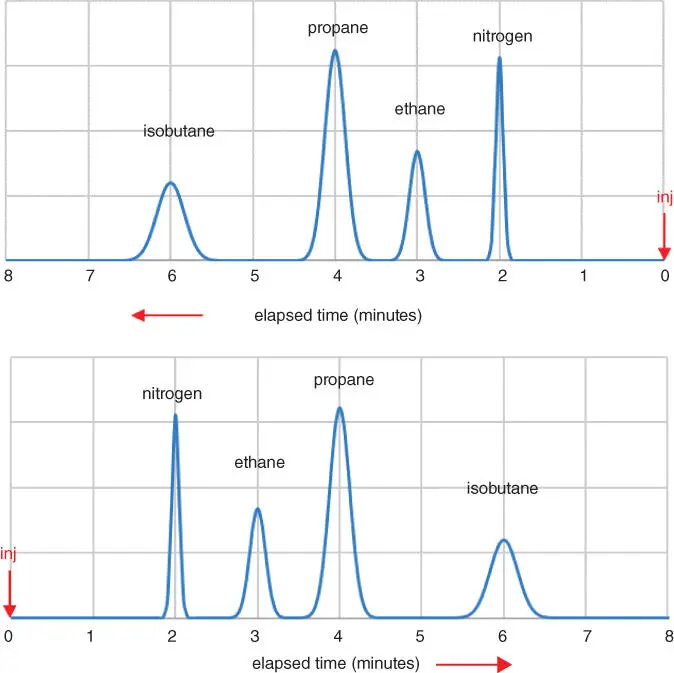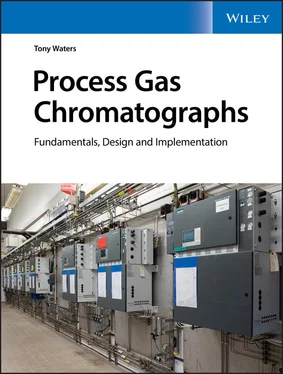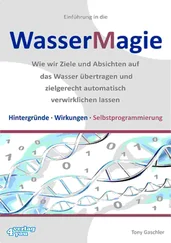1 ...6 7 8 10 11 12 ...21 The type of column so produced depends on the role of the solid particles:
An active‐solid column contains solid particles having a large activated surface area to selectively adsorb certain molecules from the sample gas.Since the stationary phase is solid, this technique is gas‐solid chromatography (GSC).
A liquid‐phase column contains solid particles having a coating of non‐volatile liquid to selectively dissolve certain molecules from the sample gas.Since the stationary phase is liquid, this technique is gas‐liquid chromatography (GLC).
Many columns now use proprietary stationary phases, often made from specialized polymer material. These columns don't easily fit into the old classifications of GSC or GLC, so the terminology is becoming passé.
In a liquid‐phase column, we call the granular solid an inert support. In real life, an inert support might not be completely inert; it sometimes affects the performance of a column.
The thickness of the liquid film coated on the support is an important variable. The liquid loadinggives the percentage by weight of liquid on support.
The first gas chromatographs used packed columns, and they are commonly found in PGCs today.
Open‐tubular columns
An open‐tubularor capillary columnuses several tens of meters of capillary tubing having an internal diameter ranging from about 100 to 530 μm. The mode of operation differs: the stationary phase adheres to the inner wall of the tube, and the carrier gas flows down the middle. Figure 1.6illustrates three versions (Harvey 2017):
A “wall‐coated open‐tubular” or WCOT column uses tubing made of fused silica. The stationary phase is a very thin layer of a non‐volatile liquid coated on the inside wall of the tube to selectively dissolve sample molecules from the sample gas. PGCs rarely use these columns as they are fragile and tend to be unstable in use.The WCOT columns typically use fused‐silica tubing and tend to be too fragile for process use. The PLOT and SCOT columns mostly use steel capillary tubing. Figure 1.6Three Kinds of Capillary Column.
A “porous‐layer open‐tubular” or PLOT column uses stainless steel capillary tubing. The stationary phase is a very thin layer of solid material coated on the inside wall of the tube to selectively adsorb sample molecules from the sample gas.
A “support‐coated open‐tubular” or SCOT column typically uses stainless steel capillarytubing. The stationary phase is a coating on very fine support particles in a uniform layer on the inner wall of the tube. These rugged columns have become quite popular in process gas chromatographs.
Open‐tubular columns have smaller diameters than packed columns and require special operating techniques. As in packed columns, the film thickness is an important variable, but we'll defer discussion on that. While they achieve better separations, the operating conditions of open‐tubular columns can be difficult to sustain in the process environment.
For more information about column types and column liquid phases, refer to the excellent detailed review by Rahman et al. (2015).
The detector
Making the measurements
A chromatographic separation cannot produce a measurement. Chromatography is merely a separating technique; it doesn't measure anything. To measure the concentration of the analytes, the analytical instrument must estimate the quantity of selected molecules as they elutefrom the column. It follows that every gas chromatograph needs a device to generate a signal proportional to the number of sample molecules exiting the column. This is what a detector does.
In any gas chromatograph, two things are happening in series. First the column separates the analytes, and then the detector measures them. To improve your troubleshooting ability, keep that distinction in mind .
Many detectors are available for gas chromatography, most developed for applications that require selective measurement or enhanced sensitivity.
The thermal conductivity detector(TCD) was the first gas chromatograph detector, and after much improvement it is still popular today. The TCD responds to the difference in thermal conductivity between pure carrier gas and carrier gas that contains sample molecules. So, when a TCD is used, the carrier gas is chosen to maximize the difference in thermal conductivity between the carrier gas and the analytes. The TCD is a general‐purpose detector that will respond to any analyte.
Most other detectors are selective; they respond only to certain kinds of molecules and often do so with very high sensitivity. For instance, the flame ionization detector(FID) responds only to compounds containing both carbon and hydrogen, so it's very useful in the analysis of hydrocarbons. The flame photometric detector(FPD) is also very sensitive, but only to sulfur or phosphorus compounds. It's most used to measure sulfur compounds in fuels and stack emissions to ensure compliance with environmental regulations.
Generally, detectors operate in the differential mode. When pure carrier gas is passing through a detector, its output signal should be constant. The analytical instrument reads that signal and offsets it to a value close to zero. We call that the baseline. Then, when the detector responds to the presence of analyte molecules, the instrument outputs a change in signal level proportional to the concentration of that component.
Chapter 10provides a detailed review of the three detectors most used in process gas chromatographs (TCD, FID, and FPD) and briefly mentions some other detectors that are common in laboratory instruments but only occasionally deployed for online process applications.
The chromatogramis a graphical display of the detector signal plotted against elapsed time. The PGC may print the chromatogram on a chart or display it on a computer screen. Note that it's also common to refer to the raw signal from a detector as the chromatogram signal.
Be careful of the terminology: the chromatographis an instrument, not a graphical plot.
The horizontal axis of the chart indicates elapsed time from the instant of sample injection. Chromatograms from an older PGC using a strip‐chart recorder may look like the one in Figure 1.7a, with the zero‐time mark on the far right and elapsed time progressing from right to left. But modern PGCs now display and print chromatograms with time‐zero on the left and elapsed time increasing from left to right, as in Figure 1.7b. You need to be comfortable with either mode of display.
Illustrative graphics: (a) Upper. Classic strip‐chart record; sample injection at right, time progresses right to left. (b) Lower. Modern on‐screen display; sample injection at left, time progresses left to right. 
Figure 1.7Typical Chromatograms.
Note: The book uses many simplified chromatograms like these to illustrate chromatographic principles: they do not represent real chromatograms .
The vertical axis of the chart indicates detector response. Chromatograms in this book don't show a calibrated vertical axis because it's rarely significant. The chromatogram is just the raw detector response, and the PGC must heavily process that signal to yield the analytical measurements.
When working on a computer‐controlled PGC, you can expand or compress the horizontal or vertical axes of the chromatogram to obtain a more detailed view of the area of current interest.
Читать дальше













